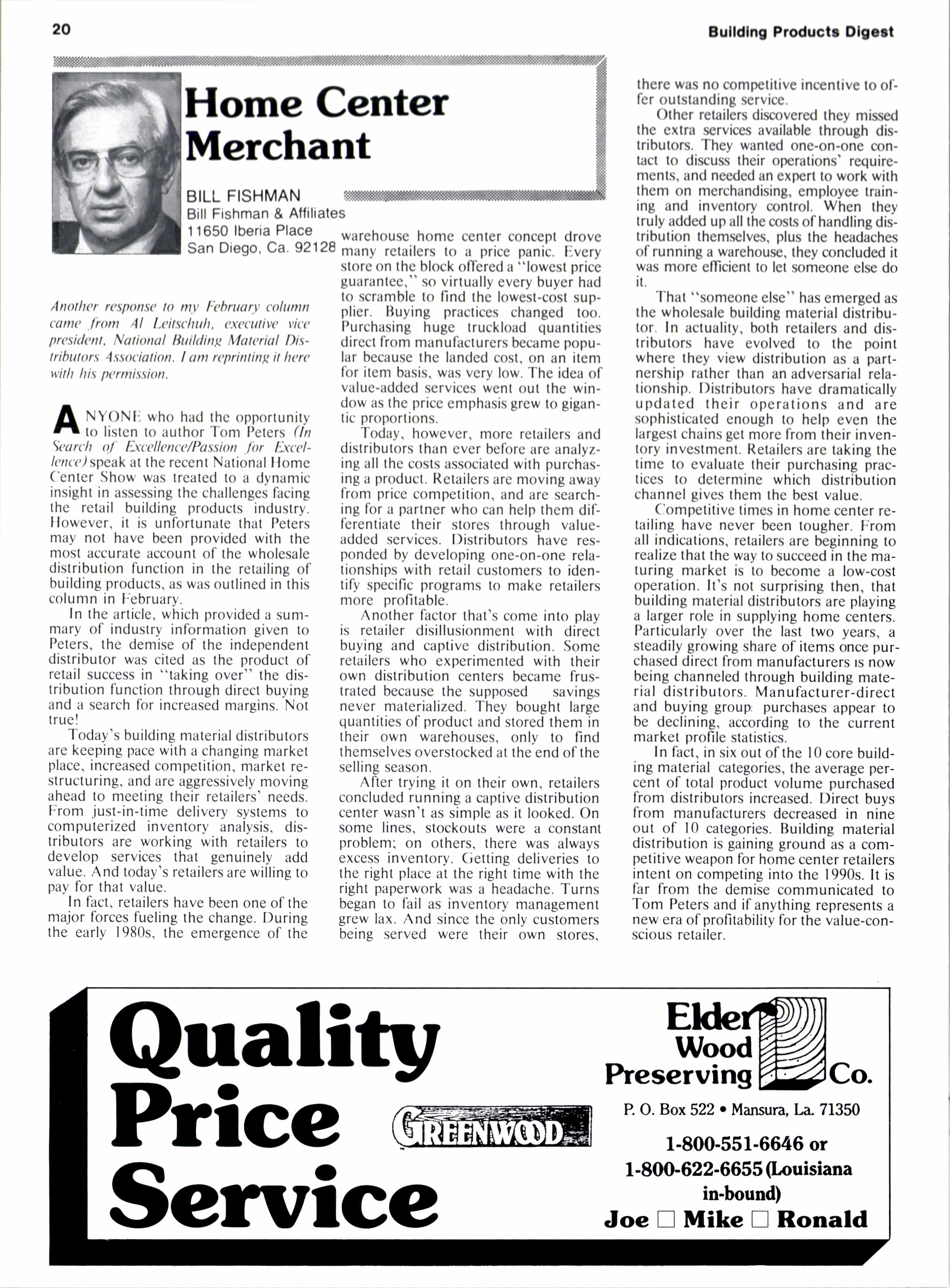
3 minute read
Home Center Merchant
BILL FISHMAN
Bill Fishman & Affiliates
'l
Another respons( lo m.t, f.-ebruar.v column cam( .lrom 4l I.eitst'huh, ey&'utiv( tic( presklttrt, Natiutctl lluiklins Matuiol Distrihulors 4ssocialion. I am reprinting il herc w'ith ltis perntission.
I NV<INtr who had the opporruniry ln the article, which provided a summary of industry information given to Peters, the demise of the independent distributor was cited as the product of retail success in "taking over" the distribution function through direct buying and a search for increased marsins. Not true! ln lact. retailers have been one of the major forces fueling the change. During the early 1980s, the emergence ol the guaranlee," so virtually every buyer had to scramble to find the lowest-cost sup- plier. lluying practices changed too. Purchasing huge truckload quantities direct from manufacturers became popular because the landed cost, on an item for item basis. was very low. The idea of value-added services went out the window as the pricc emphasis grew to gigantic proportions.
Fl (rl listcn to author Tom Peters (/r Search ol Excellcncc/Passion lbr l:x<'cllenu,)speak at the recent National llome ('enter Show was treated to a dvnamic insight in assessing the challengei facing the retail building products industry. llowever. it is unfortunate that Peters may nol have been provided with the most accurate account of the wholesale distribution function in the retailins of building products, as was outlined in-this column in ljebruary.
Today's building marerial distributors are keeping pace with a changing market place, increased competition, market restructuring, and are aggressively moving ahead to meeting their retailers' needs. From just-in-time delivery systems to computerized inventory analysis, distributors are working with retailers to develop services that genuinely add value. And today's retailers are willing to pay lor that value.
Today, however, more retailers and distributors than ever before are analyzing all thc costs associated with purchasing a product. Retailers arc moving away from price competition, and are searching for a partner who can help them differentiate their stores through valueadded services. l)istributors have responded by developing one-on-one relationships with retail customers to identily specific programs to make retailers more profitable.
Another lactor that's come into play is retailer disillusionment with direct buying and captive distribution. Some retailers who experimented with their own distribution centers became lrustrated because the supposed savings never materialized. They bought large quantities of product and stored them in their own warehouses, only to find themselves overstocked at the end ofthe selling season.
After trying it on their own, retailers concluded running a captive distribution center wasn't as simple as it looked. On some lines, stockouts were a constant problem; on others, there was always excess inventory. (ietting deliveries to the right place at the right time with the right paperwork was a headache. Turns began to fail as inventory management grew lax. And since the only customers being served were their own stores, lhere was no competitive incentive to ol'fer outstanding service.
Other retailers discovered they missed the extra services available through distributors. They wanted one-on-one contact to discuss their operations' requirements, and needed an expert to work with them on merchandising, employee training and inventory control. When they truly added up all the costs of handling distribution themselves, plus the headaches ofrunning a warehouse, they concluded it was more eflicient to let someone else do ir.
That "someone else" has emerged as the wholesale building material distributor. In actuality, both retailers and distributors have evolved to the point where they view distribution as a partnership rather than an adversarial relationship. I)istributors have dramatically updated their operations and are sophisticated enough to help even the largest chains get more from their inventory investment. Retailers are taking the time to evaluate their purchasing practices to determine which distribution channel gives them the best value.
('ompetitive times in home center retailing have never been tougher. l-'rom all indications, retailers are beginning to realize that the way to succeed in the maturing market is to become a low-cost operation. It's not surprising then, that building material distributors are playing a larger role in supplying home centers. Particularly over the last two yearst a steadily growing share of items once purchased direct from manufacturers ts now being channeled through building material distributors. Manufacturer-direct and buying group; purchases appear to be declining, according to the current market profile statistics.
In fact, in six out of the l0 core building material categories, the average percent of total product volume purchased lrom distributors increased. Direct buys lrom manufacturers decreased in nine out of l0 categories. Building material distribution is gaining ground as a competitive weapon for home center retailers intent on competing into the 1990s. It is lar from the demise communicated to Tom Peters and i[anything represents a new era of profitability for the value-conscious retailer.










